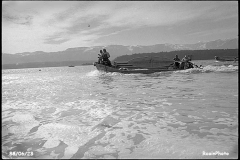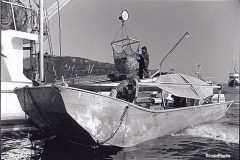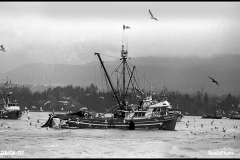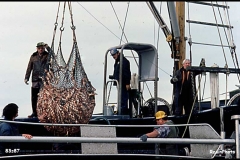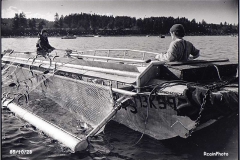Despite the positive big picture outcome, this election exposed a glaring vulnerability within our electoral system. And that vulnerability caused otherwise smart people to forget how our Canadian parliamentary system actually works. Namely: We do not have a proportional representation form of government. But there is a simple solution.
Islands Trust Comments
These are the written comments made about the four Islands Trust representative by Electoral Area A respondents who participated in Decafnation’s Local Government Performance Review. Comments that breached our journalistic standards have been eliminated. All other comments appear as entered into the online survey platform. Click on each image to enlarge the view.
David Critchley — Denman
⇒ Don’t know his work.
⇒ Does not adequately connect with all sectors of Denman’s community.
⇒ Only 2nd time I’ve heard his name. 1st time, he apparently did not know there is a shortage of affordable housing on Denman. Really dude, open your eyes!! Be in touch with the people who live in the area you represent.
⇒ Has has had to take a lot of complaints on the Denman Green which is undeserved. David cares about the community and listens to all points of view prior to making a decision.
⇒ My general sense about the Islands’ Trust is that it’s getting progressively more expensive, for progressively fewer benefits. Despite all the cost increases, Denman’s population keeps growing, and the environment gets further and further away from a “natural” one. My suggestion would be that our LTC’s mandate should be limited to land use applications only, and any surplus funds directed to health care.
⇒ Taxes for the Trust are almost as big as for the hospital. What does the Trust do except hold complicated meetings?
⇒ David seems to stand up for what is right in preserving the beauty and fabric of the Denman community.
⇒ Trustee Critchley is a lawyer and performs his LTC job officiously. He tends to take a conservative position on certain issues, particularly housing which has become a hot-button again as the IT Council has decided to crack down on non-conforming dwellings and has been issuing eviction notices since last winter. These “illegal” dwellings have existed on this Island for 47 years—ever since the imposition of the Islands Trust. They exist because they are critically necessary: the AVERAGE age on Denman is 61 years old and younger workers of every sort are needed—and need places to live. Trustee Critchley has tended to support the recent crackdown on non-conforming dwellings. About 20% of our population lives in these.
⇒ Works hard, ethical, great work on marine issues
⇒ David is extremely out of touch with the community. His current actions are an embarrassment to humanity in regards to acknowledging that a housing crisis exists.
⇒ Critchley is choosing to ignore/dismiss a housing crisis happening under his nose, in spite of it being brought to his attention on numerous occasions. He does not engage with his community, not does he speak up on serious issues that impact people.
⇒ This trustee is out of touch. He says he doesn’t know anything about the current housing crisis on Denman (it has been a long time coming but recent Bylaw enforcement has forced evictions on Denman Island). He attends meetings and committees and as far as I can tell that is all he does. He neither communicates regularly with the community. Nor is he approachable. Nor does he listen to feedback from his constituents. Time to retire Mr. Critchley.
⇒ I’m not sure if I’m dissatisfied with the performance, or more lack of performance. I have gone to him 3 times about checking on a possible by-law infraction, asking for clarification on it and he’s not offering guidance. He says there is no way to find out about permits until after they’re approved. We both said that wasn’t satisfactory, but he didn’t offer to put forward a way to change that.
Alex Allen — Hornby
⇒ He is a good communicator and raises issues which are pertinent to life on the island.
⇒ Not sure what he has done for us. First time I’ve seen his name. Don’t live on Hornby.
Grant Scott — Hornby
⇒ He’s learning the ropes and is committed to making the Trust more accessible.
⇒ Not sure what he has done for us. First time I’ve seen his name. Don’t live on Hornby.
⇒ Seems disengaged
Laura Busheikin — Denman
⇒ She’s a very clear speaker and well organized, but I don’t follow Denman issues.
⇒ Admirable!
⇒ I know Laura brings up concerns and issues that need to be addressed. I.E. low-income housing. She is well-spoken and kind.
⇒ She doesn’t really answer your questions. I find the local gov. It making it difficult for landowners. They have never made bylaws for the farm plan.
⇒ At times has spent too much time on First Nations issues instead of local day to day infrastructure concerns. Otherwise, Laura is a wonderful, considerate, intelligent representative for our community.
⇒ Don’t live on the island
⇒ Laura is very responsive to community needs.
⇒ My general sense about the Islands’ Trust is that it’s getting progressively more expensive, for progressively fewer benefits. Despite all the cost increases, Denman’s population keeps growing, and the environment gets further and further away from a “natural” one. My suggestion would be that our LTC’s mandate should be limited to land use applications only, and any surplus funds directed to health care.
⇒ The Trust has outlived its mandate. They make projects up to look busy.
⇒ Laura responds and acts upon demands and requests from a very small select group of total idiots on Denman’s Facebook group! Laura’s reading and interacting with these Facebook posts is extremely dangerous, as I truly believe they do NOT represent the views of the silent and vast majority of people on Denman at all! She should remain distanced and non-commital to these people and simply take their views into account in the overall scheme of things. For example, she should NOT be promoting lowering the standard of bylaw enforcement to support this small group of people who would love to see Denman become a slum of trailers, shipping containers and live in vehicles. She should not suggest, for example, that seacans would be a great solution to the housing shortage. If people are not able to afford living on Denman for whatever reason, then they should seek housing elsewhere in the much larger world out there where there are much larger taxpayer-funded programs to assist such people. I do not believe the argument that homeless type people are needed to staff the businesses on Denman is a good one. With some exceptions, for the most part, businesses are staffed by the owners or young people living with their families on the island. There is no need to promote homeless type people moving here to staff the businesses. These people are not the main workers here. They come to Denman because it has a reputation for low-cost living and lax rules. Then they expect to be handed a place to live for practically nothing and to live off of this very generous community’s handouts.
⇒ Laura is by far the best Islands Trustee we’ve had in the 31 years I’ve lived on Denman Island. She’s smart, hard-working, and faultlessly ethical despite being cast, in some Islanders’ minds, as a foil to Local Trust Committee members whom they regard as “elitists.” I’m sure she wouldn’t agree with that characterization, but it relates to her tireless, decade-long effort, before she was elected Trustee, to realize a creative housing solution, the “Coho Landing” co-housing development (fifteen households sharing a number of amenities to reduce environmental footprint and offering affordable opportunities whenever old members move on and new ones are lucky enough to fill their spot; all required special land-use zoning). Laura spearheaded this community project and, probably for this reason, many voters expect her to represent their concerns about the chronically severe lack of affordable housing on our Island. She works well with her LTC colleagues and within the rules, nevertheless. Very professional—and a very nice person, too!
⇒ Laura B is the hardest working, clearest communicating, most democratic process-oriented I’ve experienced in 35 years of full-time residence on Denman.
⇒ Very engaged, great communicator, patient, fair-minded, ethical
⇒ Laura is extremely intelligent and very aware of what is happening on her island, has articulated truth in LTC meetings, and regularly engages with her community
⇒ One of our very best trustees. An excellent elected official








